Discover the Diversity of Alocasia
Alocasia, a member of the Araceae family, is native to Southeast Asia, southern China, and eastern Australia. This plant is particularly appealing to plant enthusiasts thanks to its impressive tropical beauty, characterized by large, striking leaves with prominent veins. The different species of Alocasia showcase a variety of leaf shapes and textures, creating an irresistibly diverse collection. These plants thrive in bright, indirect light and require high humidity, reflecting their natural adaptation to the understory of tropical rainforests. This is why Alocasia is commonly grown in tropical climates like those of Southeast Asia. Interestingly, their ancestors were used as food for centuries, and after being cultivated over time, Alocasia has become a popular indoor plant, exuding both elegance and classic charm.
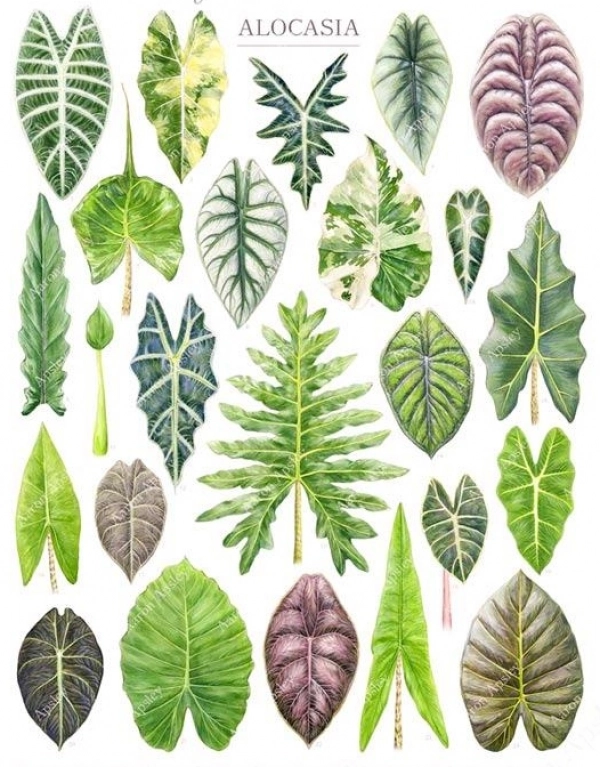
A unique feature of Alocasia is the upright growth of its leaves, rather than spreading out like many other tropical plants. When grown outdoors, Alocasia blooms in spring, producing a characteristic inflorescence called a spadix. The flowers consist of a central spadix surrounded by a spathe, similar to the blooms of Peace Lilies. However, when grown indoors, flowering is quite rare.
Popular Alocasia Varieties
There are around 97 species of Alocasia worldwide, but only 9 are widely used and popular among plant lovers.
1. Alocasia Dragon Scale (Alocasia Baginda Dragon Scale)
Alocasia Dragon Scale stands out with its dark green leaves, featuring distinct veins that resemble the scales of a dragon, true to its name. Although the exact origin of this plant remains a mystery, many believe it hails from East Kalimantan, Borneo, where the tropical rainforest climate and rich ecosystem provide an ideal habitat. Dragon Scale can produce flowers, but its white and purple blooms are not the plant's main attraction. The flowers often resemble young leaves and are quite difficult to cultivate to full beauty. Thus, the allure of Alocasia Dragon Scale lies primarily in its leaves, making it a favorite among foliage plant enthusiasts.
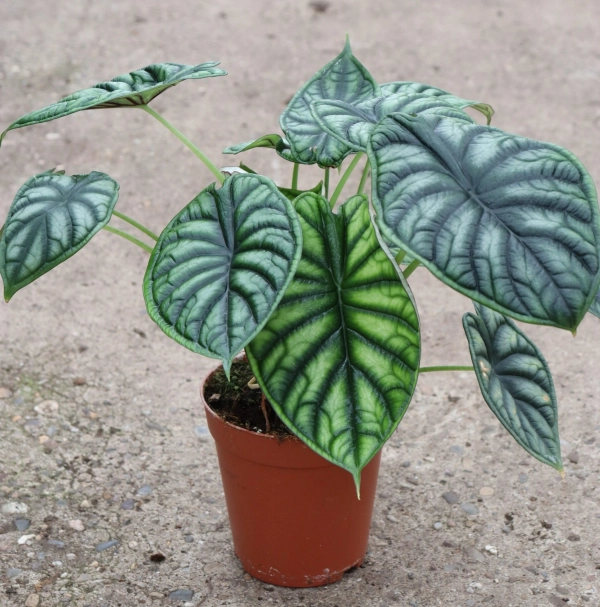
2. Alocasia Silver Dragon (Alocasia Baginda Silver Dragon)
Alocasia Silver Dragon captivates with its thick, heart-shaped leaves and unique color. Its leaves are a silvery hue, accented by dark green veins. However, it takes time for the plant to reach its mature beauty. When young, the leaves are typically small, smooth, and bluish-green. As the plant matures, the leaves gradually turn silver, with the veins becoming more prominent. Like the Dragon Scale, the Silver Dragon is native to Borneo and some subtropical regions in Asia, such as Indonesia and eastern Australia. Growing to an average height of under one meter, this plant thrives best in spring and summer. Once considered a rare species, the Alocasia Silver Dragon has become more common in recent years due to successful cultivation efforts.
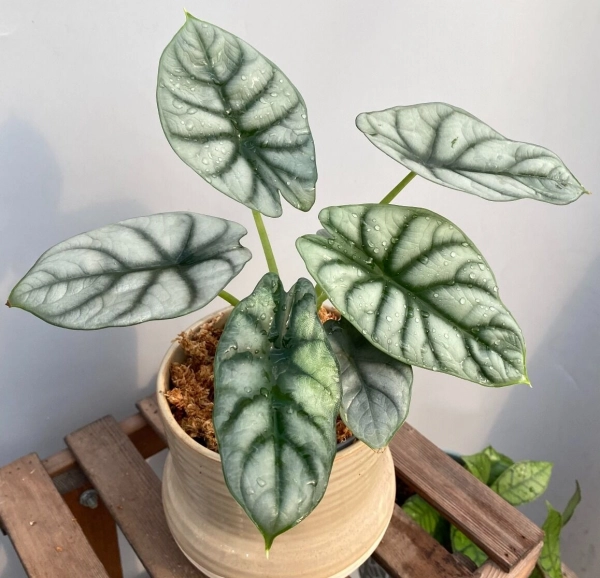
Though often confused, Alocasia Dragon Scale and Silver Dragon are distinct species. The most noticeable difference is the color: Silver Dragon has lighter, silvery leaves, while Dragon Scale's foliage is much darker.
3. Alocasia Grey Dragon (Alocasia Maharani)
Alocasia Grey Dragon, scientifically known as Alocasia Maharani, stands out with its thick, soft leaves. Its unique blue-gray foliage is dominated by a greenish tone, with a subtle gray sheen, and the underside of the leaves displays a reddish hue. This plant is found in regions near present-day India, and the name "Maharani" — a term used to refer to a queen or princess in Hindi — was given to this species. Alocasia Grey Dragon adapts well to various climates, making it popular in many regions. It may produce small ivory-colored flower clusters in early spring, but when grown indoors, the blooms tend to be short-lived and wilt quickly.
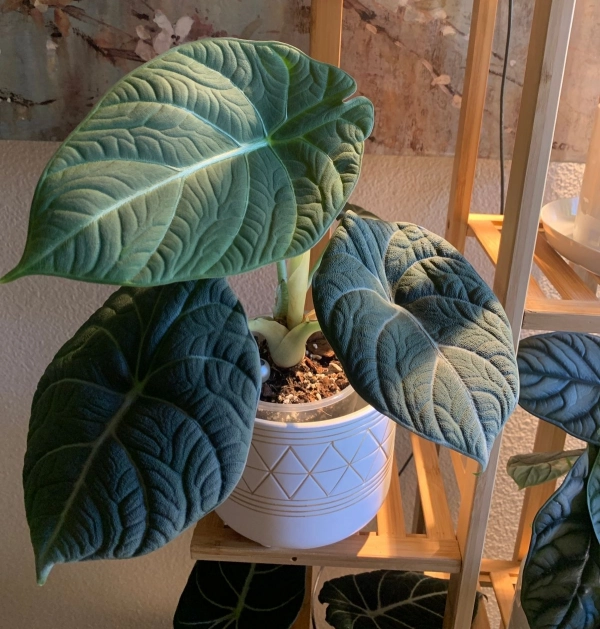
4. Alocasia Amazonica Polly (Alocasia Polly)
Amazonica Polly, scientifically known as Alocasia Polly, is one of the most distinctive and popular hybrid varieties of the Alocasia family. With its compact size and unique appearance, it’s often described as an "alien" in interior decoration. Its heart-shaped, glossy leaves are highlighted by striking creamy white veins and wavy edges, giving it a stunning look. Despite the name "Amazonica," there is no evidence that this plant originates from the Amazon rainforest. In fact, the name comes from the hybrid Alocasia x amazonica, created in the 1950s by Salvadore Mauro, a plant grower in Florida, who crossed Alocasia Watsoniana and Alocasia Sanderiana, naming it after his business, "Amazon Nursery." Amazonica Polly has ancestral roots in the tropical rainforests of southern China, Southeast Asia, and the Philippines, lending it a mysterious and alluring charm. While it rarely flowers indoors, with proper care, it can still produce small, pale-colored blooms.

5. Alocasia Black Velvet (Alocasia Reginula)
Alocasia Black Velvet, scientifically known as Alocasia Reginula, stands out with its smaller foliage compared to other Alocasia species. Its velvety leaves are smooth, with a dark black base that contrasts sharply with crisp white veins. This plant brings the wildness of the jungle into any setting, yet its modern and elegant look makes it suitable for all spaces, even the smallest ones. Many mistakenly believe that Alocasia Black Velvet is a hybrid, but it is actually a natural species, discovered in the tropical forests of Sabah, Borneo. Though commercialized since the 1860s, this plant was only introduced as an indoor plant in 1998. A 2021 study confirmed that Alocasia reginula is endemic to the Tabin Wildlife Reserve in Sabah, Malaysia, where it grows on shady limestone cliffs. Despite its slow growth, Alocasia Black Velvet thrives in both acidic and neutral soils, making it an easy-care, captivating plant.

6. Alocasia Frydek (Alocasia Micholitziana Frydek)
Alocasia Frydek, also known as Green Velvet Alocasia, is scientifically named Alocasia Micholitziana Frydek. While its heart-shaped leaves resemble those of other Alocasia species, Frydek’s foliage is more elongated, giving it a natural, graceful beauty as they droop down. The dark green leaves deepen toward the center, meeting at creamy white veins, creating a subtle contrast. This shade-loving plant can be grown outdoors but requires careful watering. When well cared for, Frydek can grow taller than one meter. Its flowers are softly fragrant and pale yellow, though their blooming period is quite short.
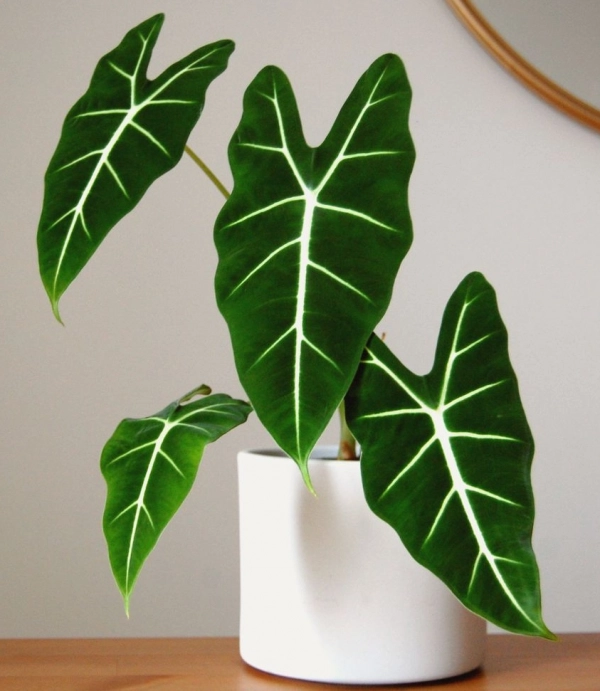
This plant is native to the northern Luzon region of the Philippines. The name Frydek was given by botanist Henry Frederick Conrad Sander in 1912 to honor his friend, renowned botanist Wilhelm Micholitz, who conducted several expeditions throughout Southeast Asia to study tropical plant species. The word "Frydek" may have roots in Old German, meaning "peaceful" and "noble."
7. Alocasia Red Mambo (Alocasia Azlanii)
Alocasia Red Mambo, scientifically known as Alocasia Azlanii, is characterized by its upright, 20 cm long leaves that display a unique range of colors from wine red to glossy black, while the edges retain a green hue. Recently discovered in Malaysia, this plant was identified and studied by Azlan Pandai, a plant collector from Brunei, and was named in his honor. Alocasia Azlanii was classified in 2016 and was initially found only in Sarawak, Borneo. Although its breeding process is quite complex, it is relatively easy to care for, as the plant can recover quickly even after losing all its leaves.
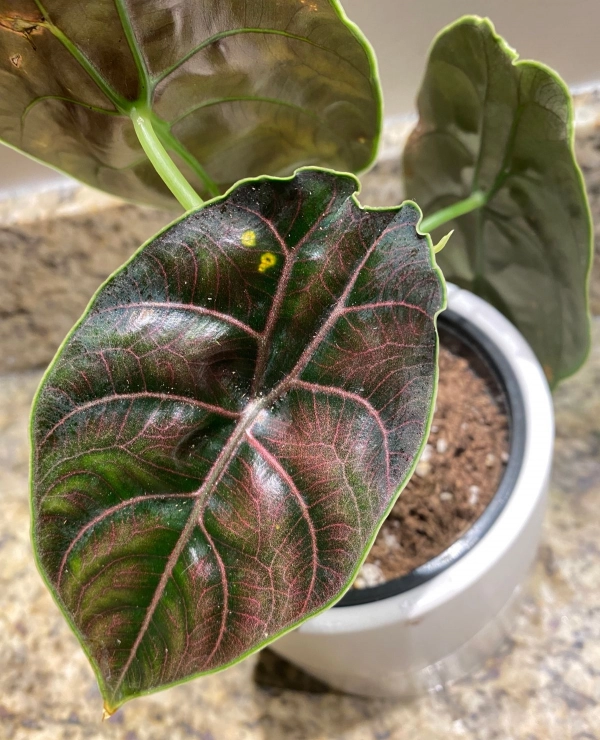
8. Alocasia Red Secret (Alocasia Cuprea)
Alocasia Red Secret, also known scientifically as Alocasia Cuprea or the "Mirror Plant," is striking with its rippled leaf texture and arrow-shaped central veins. The name "Cuprea" comes from the Latin word for "copper," referencing the metallic sheen reflected on the leaf surface. When young, its leaves are tinged with a purplish-green, with a chestnut-colored underside, but as the plant matures, the veins darken, producing a vibrant purple hue. The combination of red, dark green, and plum shades creates the unique allure of Red Secret. When grown under the right lighting conditions, its colors become even more vivid and radiant.
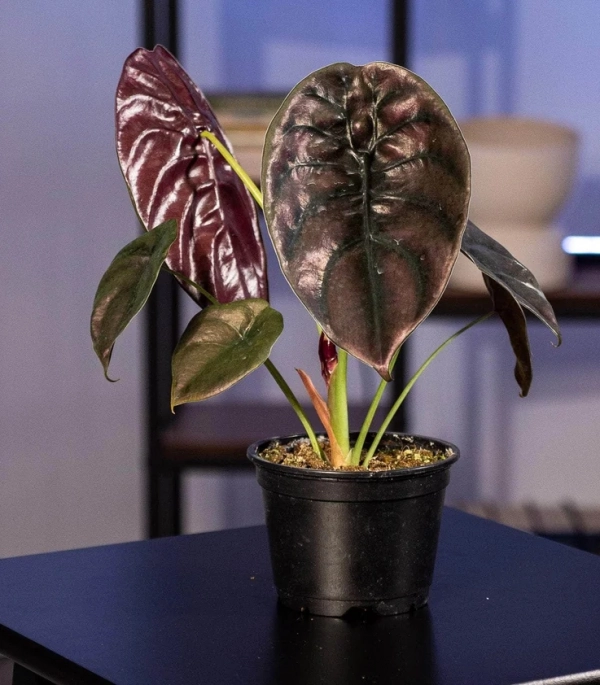
This plant is native to Southeast Asia, particularly the rainforests of Borneo, and has been known since the 1860s. Red Secret is often confused with Alocasia Azlanii due to the similarity in color and shape. However, Alocasia Red Secret has nearly round shield-shaped leaves, while Alocasia Red Mambo features larger heart-shaped leaves with darker coloring.
9. Golden Giant Taro (Alocasia Lutea Golden)
Golden Giant Taro, scientifically known as Alocasia Lutea Golden, is distinguished by its vibrant neon yellow hue. Its growth rate and leaf color vary depending on factors such as soil, light, and temperature. With a height that can reach up to 3 meters and a leaf spread of 1 meter, Golden Lutea is better suited for outdoor planting than indoors. While the leaf stalks and flowers are not as bright yellow as the foliage, they still retain a striking, vivid color.
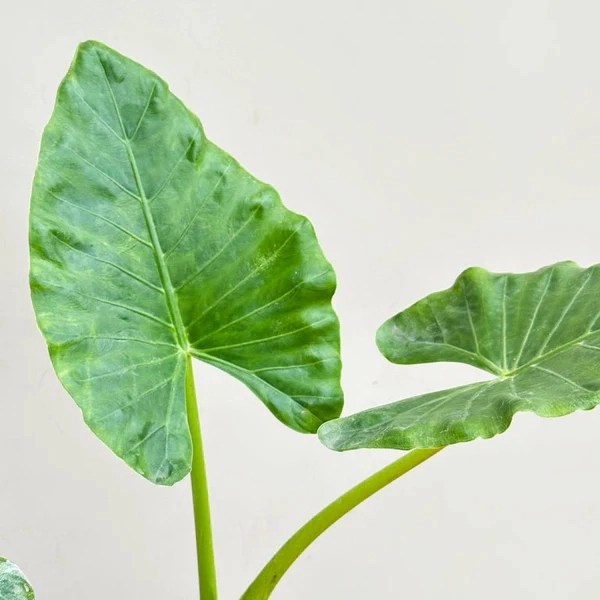
Golden Giant Taro is believed to originate from the southwestern Pacific region, with concentrated distribution in Malesia, Queensland, and the Solomon Islands. This versatile plant can be grown as both an ornamental and a food crop.
Alocasia Care Guide
Light
Alocasia originates from tropical rainforests, where it thrives under the canopy of larger trees, so it’s not accustomed to direct sunlight. Direct sun can scorch its leaves. These plants do best in low or indirect light conditions. While light affects the growth rate, it’s important not to overexpose them. To encourage faster leaf growth and a broader canopy, ensure that Alocasia receives as much indirect light as possible.
Watering
Alocasia prefers slightly dry soil between waterings but requires high humidity to thrive. You can monitor the soil surface, and when the top layer is completely dry, it’s time to water. Alocasia also appreciates periods of dryness between bouts of moisture. Another option is to grow the plant using hydroponic methods. During dry, cold weather, the plant is prone to drying out and may need misting to maintain moisture. When watering, avoid getting the leaves wet to prevent leaf damage or drooping due to the weight of water.
Humidity
Alocasia thrives in humid environments, similar to the tropical monsoon climate of Southeast Asia, where it originates. High humidity not only helps the plant grow but also prevents infestations by pests like spider mites. To maintain humidity, you can place a pebble tray with water near the plant and ensure the air humidity doesn’t drop below 60%.
Temperature
Alocasia prefers warm environments and is sensitive to extreme temperatures, both high and low. The plant grows best between 19°C to 29°C. The ideal condition is to place it under a shade net, reducing 50% of direct sunlight, which helps stabilize the temperature. When temperatures drop below 12°C or rise above 32°C, the plant may show signs of dormancy or develop brown spots on its leaves. Avoid placing the plant in areas with temperature fluctuations, such as near windows, vents, air conditioners, or heaters, as sudden temperature changes can slow growth and damage the leaves. Alocasia often enters dormancy during the cold season, when it stops growing but doesn’t lose its leaves. Keeping the plant in a temperature range of 13°C to 16°C will help it survive through the winter.
Toxicity
Alocasia contains asparagine and oxalic acid, compounds that can cause poisoning if ingested, particularly in pets like dogs and cats. Even adults may experience vomiting and diarrhea if they consume the leaves. Although the ancestors of Alocasia were once used as food, very few species today are edible due to their high toxicity.
Common Issues with Alocasia
1. Drooping Leaves
Drooping leaves are often caused by improper watering or issues with pests, lighting, or the planting environment. Carefully check the light direction and rotate the plant regularly so that all its leaves can receive sunlight. Next, establish a new watering routine suitable for the current weather—Alocasia requires more water in hot seasons but only misting during colder months. If you've already adjusted the lighting and watering methods but the drooping continues, consider repotting the plant.
2. Pest Infestation
Alocasia is highly susceptible to spider mites (tiny spiders that often appear on the underside of leaves) and various types of aphids (mealybugs, scale insects, etc.). Additionally, leaf-eating pests like caterpillars and snails should be monitored. Dealing with these bites is part of caring for this plant. First, isolate the affected parts from the rest of the plant. Wash the leaves and stems with soap and then wipe them with neem oil. Finally, increase the humidity around the plant when placing it back in its original spot.
You can use biological or chemical pesticides to control and eliminate these pests. However, if using chemical products, ensure a proper isolation period before displaying the plant to avoid harming people and pets.
3. Excessive Leaf Shedding
Alocasia can recover even after shedding all its leaves. Rather than keeping it indoors, this is the time when it needs to be taken outdoors more than ever. However, do not expose the leaves to direct sunlight—simply place them in the shade!
4. Brown Spots on Leaves
This happens when the water used for the plant contains salts, minerals, and chlorine. This can be due to the effects of hard water or tap water with excess chlorine and heavy metals. Choose a purer water source like distilled water, or let tap water sit overnight to allow the chlorine to evaporate before watering.
5. Fertilizing Frequency
Most indoor plants thrive when fertilized during warm weather, usually from around November to April. When the rainy season comes, or when grown indoors, reduce the use of fertilizers. Overfertilizing can lead to mold and affect Alocasia’s growth, as well as other plants. However, if your plant appears weak or nutrient-deficient, you can still apply a small amount of diluted organic fertilizer once a month.
6. Repotting Frequency
For smaller desk plants, a pot can be used for about 1 to 1.5 years. Larger floor plants, due to their size, require repotting less frequently, about every 1.5 to 2 years.
Frequently Asked Questions about Alocasia
1. Is Alocasia difficult to care for?
Although many believe Alocasia has a "difficult" temperament, they are not too hard to maintain if provided with the right environment. Ensuring the plant is not overwatered and keeping it in a humid environment with filtered light will help it thrive.
2. How long can Alocasia live?
The lifespan of Alocasia depends on the species, but with proper care, including regular repotting and separating, they can live for decades.
3. Should Alocasia be grown indoors or outdoors?
Alocasia is best suited for indoor cultivation, as it requires a warm, humid environment with filtered light. If you wish to grow it outdoors, ensure it has the optimal conditions in terms of temperature and lighting.
4. What are some non-toxic alternatives to Alocasia?
If you are concerned about the toxicity of Alocasia, you can opt for safer alternatives such as prayer plants (Maranta), peperomia, Boston ferns, or Christmas cacti.
5. How to decorate a home with Alocasia?
Alocasia’s unique leaf shape and strong structure make it ideal for modern spaces or rooms with a tropical theme.
Tags: Indoor Ornamental Plants | Outdoor Ornamental Plants | Bonsai Plants | Aquatic Ornamental Plants | Miniature Ornamental Plants |










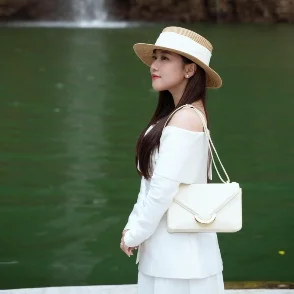
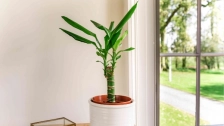
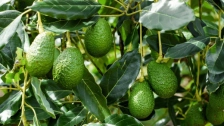
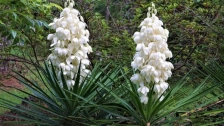






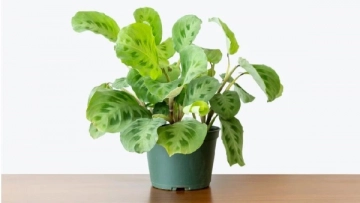

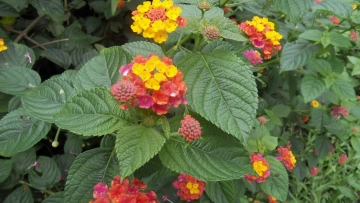
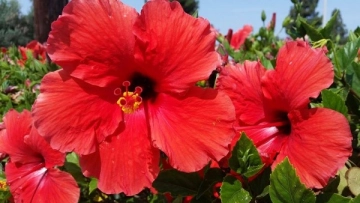
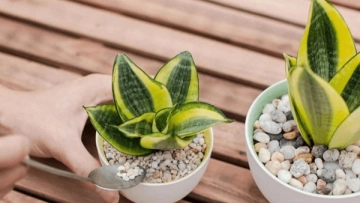
Kassia Camila
September 28 , 2024
Thanh Thao
September 28 , 2024